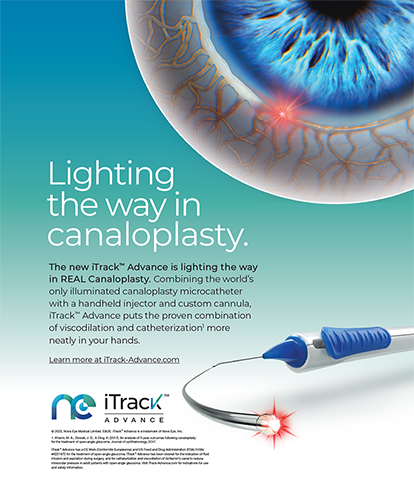When I started practicing medicine in 2001, the only preoperative diagnostic equipment I had for cataract surgery was a manual keratometer and a contact ultrasound A-scan. I used a 3.2-mm keratome, linear continuous phacoemulsification, and a spherical monofocal IOL in all of my surgical cases. At the time, I thought I had everything I needed and that my patients had great outcomes.
Today, I find it hard to believe the technological transformation the field of ophthalmology has undergone. In the last year alone, my practice has added an electronic health records system, a second femtosecond laser, a second laser biometry device, corneal collagen crosslinking, multiple new IOLs, and iPads (Apple, Inc.) in the waiting area to educate patients. During the past 5 years, we have adopted much more, including intraoperative aberrometry; three-dimensional, heads-up, digitally guided visualization; presbyopia-correcting IOLs; new-generation biometry; tear film analysis; and an intense pulsed-light laser. My corneal, retinal, and glaucoma partners are also adding technology such as lasers and injectable drug delivery devices, drainage devices, and diagnostic equipment.
How do you decide what to buy? What will be the financial and operational impact of a new device, its return on investment, and its effect on workflow? Most importantly, how will the device benefit your patients? These are not easy questions, and perhaps there are no right answers. What follows are some helpful tips.
CONSIDERATIONS FOR PATIENTS' CARE
Whether it is a $500,000 femtosecond laser or a simple instrument for marking the cornea, technology represents an opportunity to provide your patients with better care. First and foremost, you must feel confident about the decision to add the device. Unfortunately, not every decision can be based on the peer-reviewed literature. Manufacturers are creating FDA 510(k)-approved devices that are so swiftly adopted and marketed by surgeons that it is hard to objectively determine the benefits to patients. You therefore must rely on peer-to-peer communication and the opinions of those you trust. Sift through the information, and obtain accurate data on a device's strengths and weaknesses. There is no substitute for actually seeing a technology in action at another practice or having a demonstration performed at your own practice.
These steps require time and patience, but it is important to do your homework. This way, instead of second-guessing your decision, you will remain confident if you hit speed bumps down the road, as ophthalmologists often do.
FINANCIAL CONSIDERATIONS
Physicians need to make responsible financial decisions if their practices are to remain viable. With the rising cost of medical diagnostics and devices added to click fees and the cost of yearly maintenance, it is easy to see how a practice could fail financially when attempting to offer more advanced care to patients. When considering a purchase, run a pro forma to determine how the device will affect your practice's weekly and monthly cash flow. Amortizing the cost out over several years with a lease or financing is one of the tried-and-true methods for stabilizing cash flow and reducing the impact of large capital expenditures. In other situations, there can be tax advantages to purchasing capital equipment outright or using an in-house leasing company to make the purchase. Every practice's situation is unique, and financial modeling is often the best way to help you understand the impact of the decision to purchase new technology.
More and more, I hear refractive cataract surgeons express a desire to add a new piece of equipment to their practice to keep up with the growing model of patient-shared costs and the premium channel. Not everyone has the practice or resources to buy a halfmillion dollar laser. Fortunately, various other devices allow surgeons to compete in the premium cataract arena of astigmatic and presbyopic correction for a more reasonable price. For example, in my experience, the ORA System (WaveTec Vision) and the TrueVision 3D Visualization System (TrueVision Systems, Inc.) are hightech, highly marketable devices that improve outcomes in a cost-effective manner.
INTEGRATION INTO THE PRACTICE
Once you “buy in” to the benefits of a specific technology for patients, its chances for successful integration into your practice skyrocket. Your confidence in a product will influence your staff and patients.
Inevitably, new forms, protocols, and training will be needed, as well as additional time and staff. Establish a plan for integrating the technology into your practice before its acquisition or delivery. Whether a diagnostic or a surgical device, the product's impact on work flow, patient flow, staffing needs, and your schedule should be considered. Also take into account the spatial and environmental requirements of the device before making a purchase. The more planning you and your team have done, the better the experience will be for all involved, especially your patients.
No matter how well you prepare, the integration process will not always go perfectly. Software may have a glitch, and hardware fails. Before making a purchase, assess the support that vendors offer. Will they come to your site, and, if so, for how long? What is the warranty, and are software upgrades included?
THE BIG PICTURE
Taking a long- and a short-term view of your practice's goals can help you to gain perspective. Do not rush. Make the best-educated decisions you can, and work hard to be successful with whatever technology you use. Try to avoid adding too many products or procedures at once.
My main point is that there are many roads to success. By putting your patients' care and visual outcomes first, financial assessments second, and a methodical plan for technological integration third, you can raise the bar for the care you deliver.
Robert J. Weinstock, MD, is a cataract and refractive surgeon in practice at The Eye Institute of West Florida in Largo, Florida. He is a consultant to Alcon Laboratories, Inc., Bausch + Lomb, TrueVision Systems, Inc., and WaveTec Vision. Dr. Weinstock may be reached at (727) 585-6644; rjweinstock@yahoo.com.


